Story and Photos by Jonathan Sharp
The pandemic must have made the curation of the 2021 Freddy March Spirit of Aviation Trophy (held as part of the Goodwood Revival Meeting September 17–19, 2021) much harder, but as usual, the mix of aircraft on display was as eclectic as usual, from bi-planes to bombers, trainers to fighters, from wood and canvas to polished alloy fuselages.
Unlike air shows and museums, it is the ability to get very close to the aircraft that makes the event somewhat unique. No barriers, just a sign asking you not to touch the aircraft. So if you wanted to have a really close look at the wing fold mechanism of a F4U Corsair, or the list of patent numbers shown on the maker’s plaque of a Wright Twin Cyclone radial engine (it’s seventeen) this was your chance. The judges for the 2021 event included The Austrian skydiver Felix Baumgartner, Air Commodore Tony Keeling OBE, Air Marshall Martin Sampson, aerobatics pilot Nigel Lamb, the editor of Pilot magazine Philip Whiteman, GAC ambassador and airline captain Kate McWilliams, MBE, and Goodwood flying instructor Graham Turner.
For those interested in WWII aircraft, we highly recommend two movies: ‘The Longest Day’ and ‘The Battle of Britain.’
And the winners of this year’s Freddie March Spirit of Aviation Trophy?
1st place 1951 Cessna Bird Dog – Laurie Gregorie
2nd place 1941 Westland Lysander – John Romain
3rd place 1964 Westland Wasp – John Heath
Well I did say it was eclectic!
Descriptions below taken from the aircraft plaques and internet sites.
F4U-4 Corsair
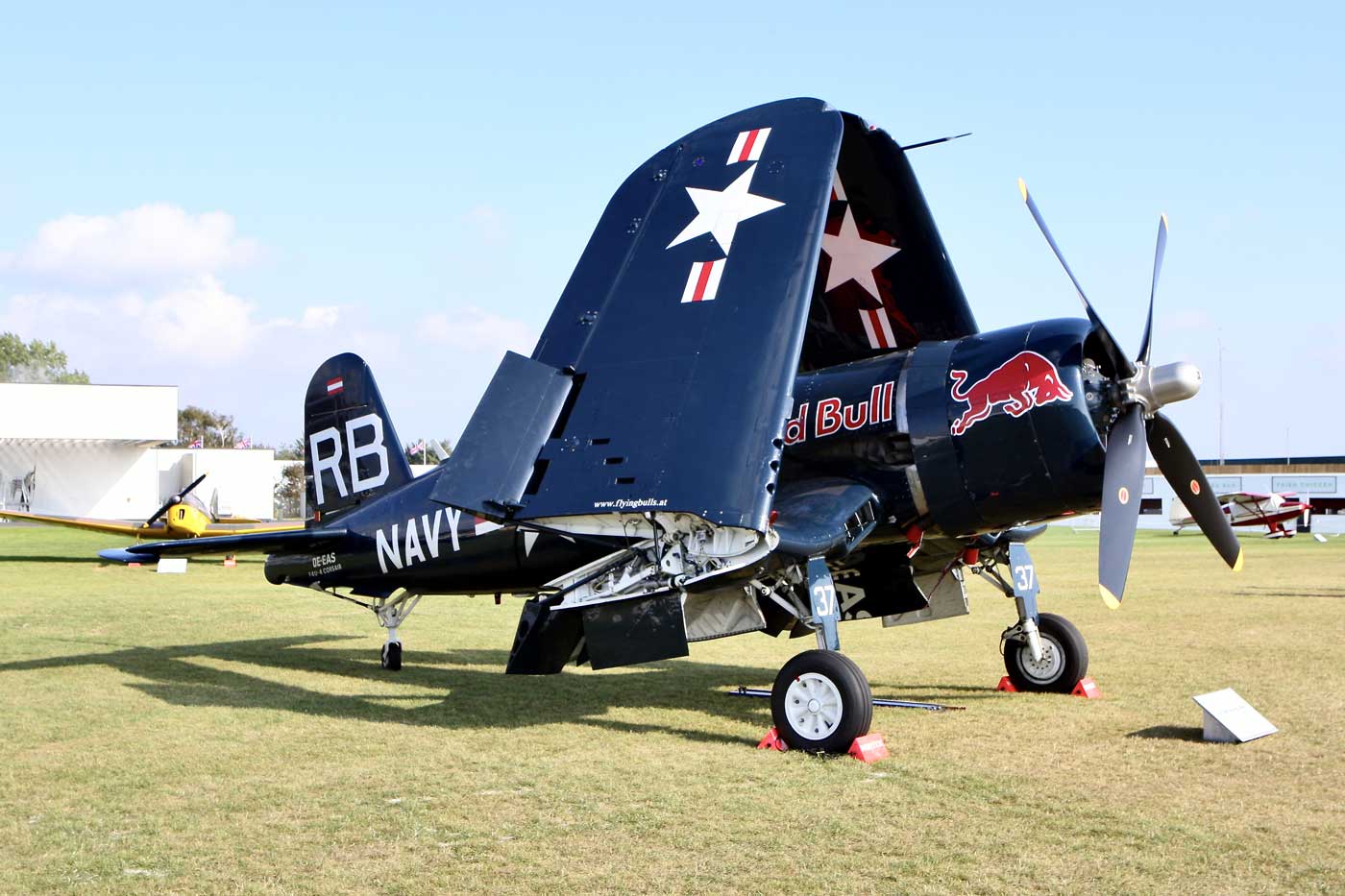
A jewel from the Red Bull/Flying Bull collection, this Chance Vought F4U-4 Corsair was built in 1945 but did not see any wartime action. After a few years the Corsair was transferred to the Honduras Air Force where she remained under active service until 1965.
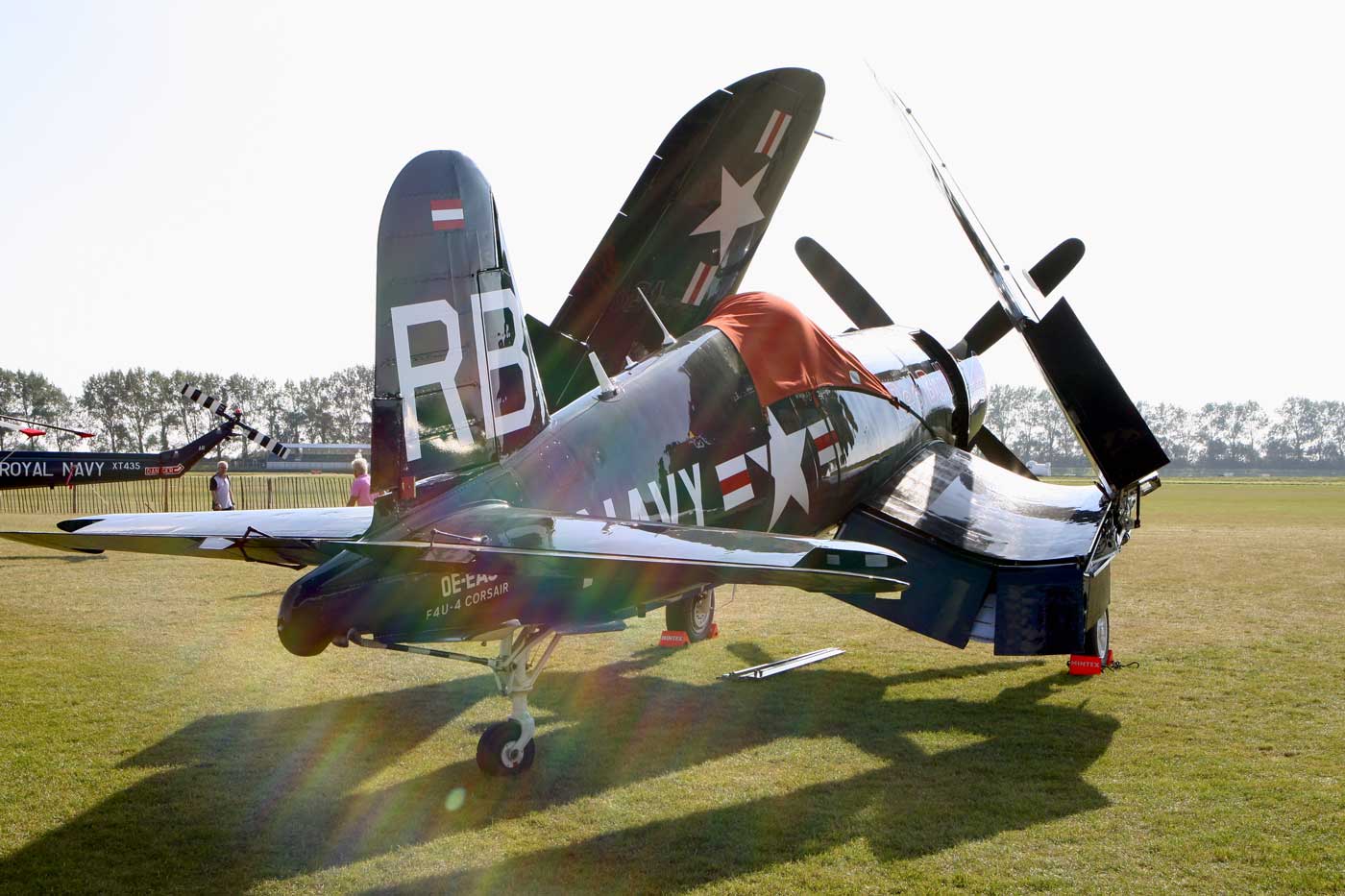
The Corsair F4U-4 of the Flying Bulls is an especially demanding plane: approximately 40 maintenance hours are needed for every flight hour. The fuel consumption amounts to an average of 400 liters an hour, even triple that at takeoff. The airplane is entirely fit for aerobatics, but it is flown conservatively because of its age. Still, 4.5 g s in a steep curve is not uncommon despite the protective treatment.
Furthermore, the top speed of 750 km/h is only seldom attained, in order to keep the engine’s wear and tear to a minimum.
North American B25J Mitchell
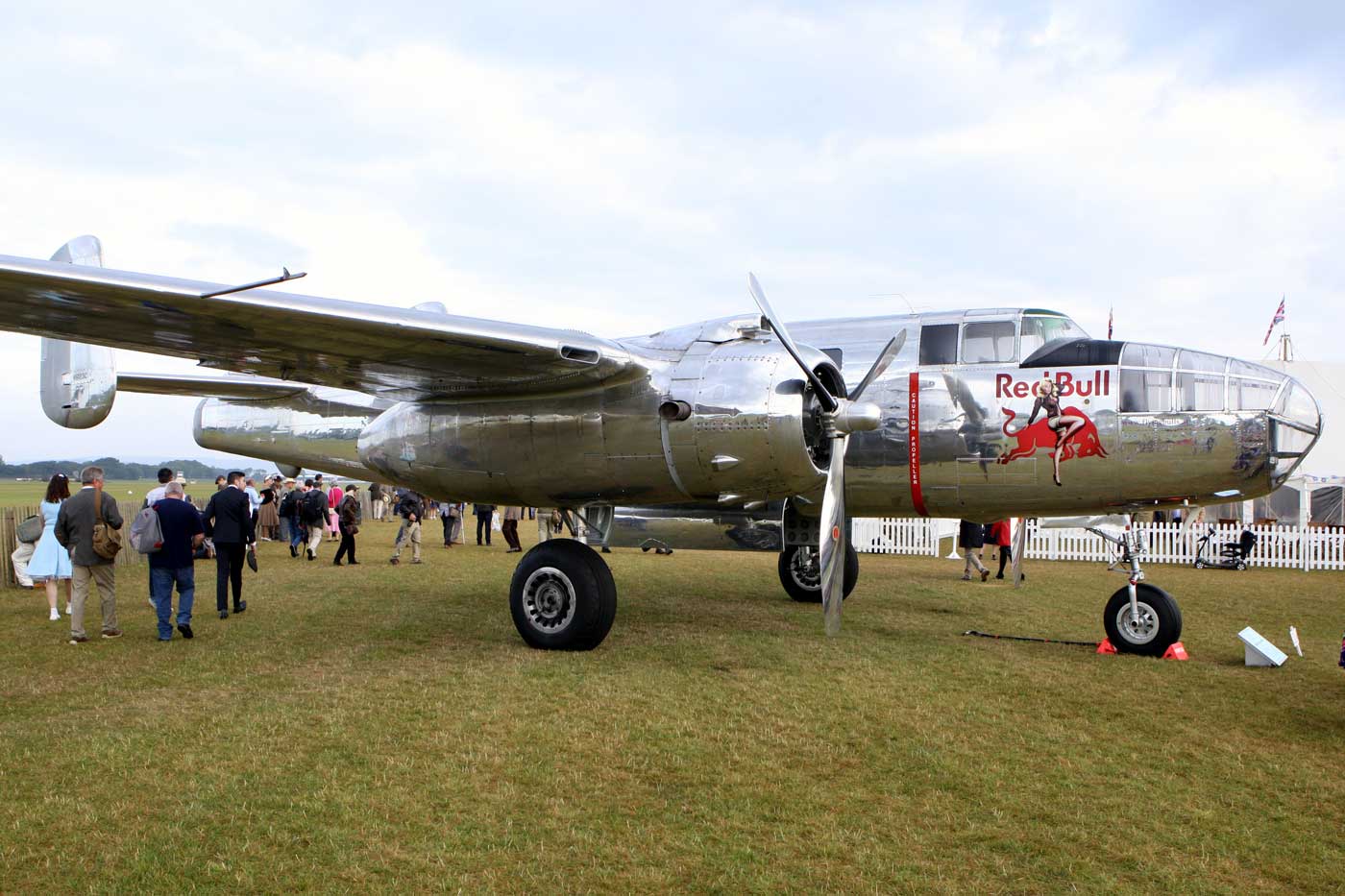
Forming part of the Red Bull ‘Flying Bulls’ collection based in Salzburg Austria this North American B25J Mitchell was constructed in Kansas City in 1945.
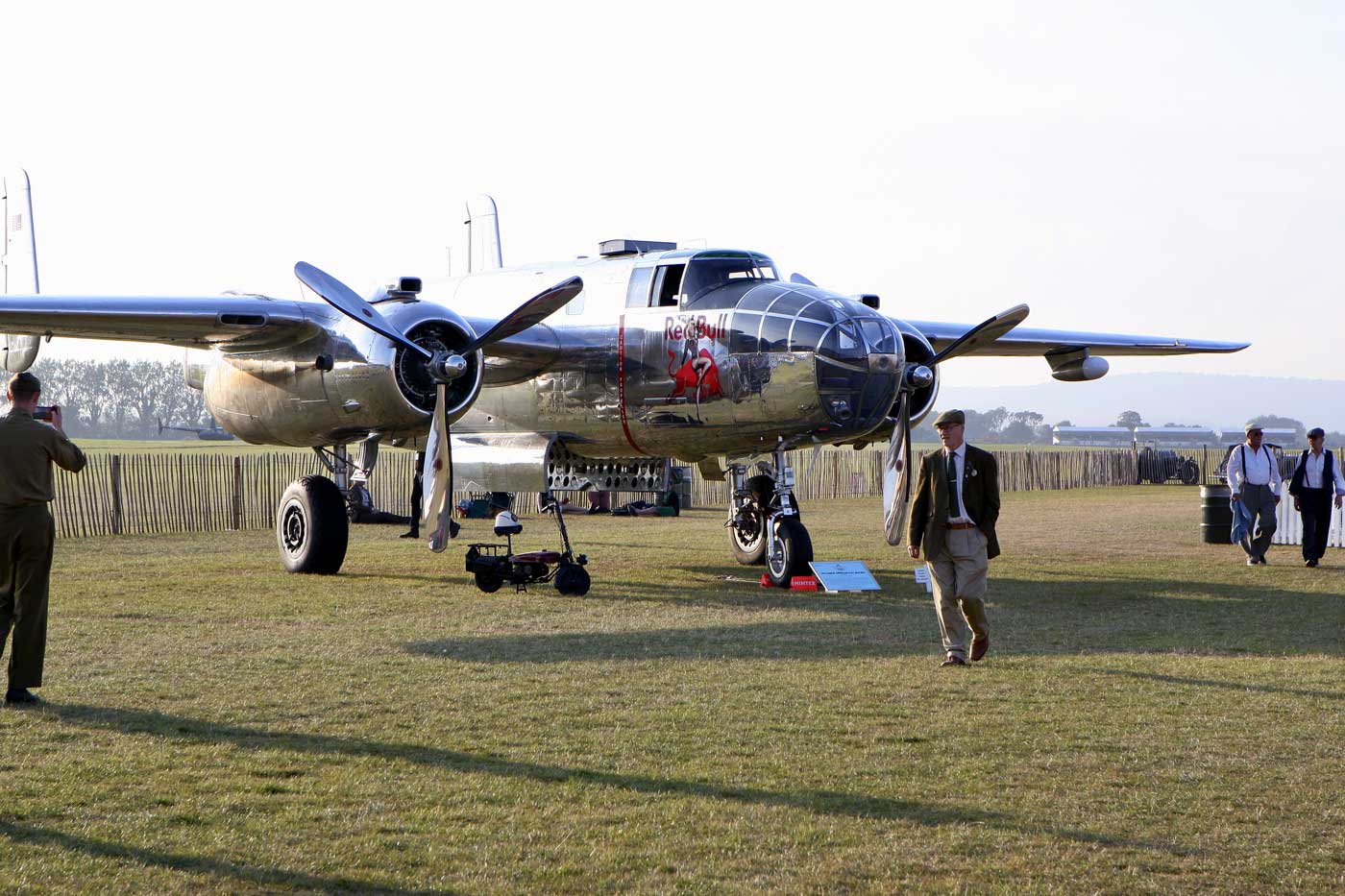
Originally used as an electronic test platform before being flown to the aircraft boneyard at Davis Air Force Base in Arizona to be mothballed. In the 1970s the B25 was purchased to be used as a water bomber for fighting forest fires but ultimately did not suffer that fate.

Acquired by a flying club in Kansas and flown at airshows as the Fairfax Ghost in the 1980s, Red Bull acquired the B25 in the 1990s and restored her from the ground up. In 1997 she was flown to Europe and in 2001 was moved to her new home in Salzburg.
North American Mustang P51D

Dan Friedkin’s North American Mustang P51D-30-NA was built in May 1945 and issued with the US Army Air Corp serial 44-74391. After service with various USAF and National Guard Units the Mustang was sold to the Guatemalan Air Force in 1958. By 1972 the Mustang was on the US Civil register as N351MX and having passed through several further owners was moved to the UK in 2018. She now carries the markings of Captain Henry William Brown from Dallas, namely “The Hun Hunter \ Texas’ of the 354th Fighter Squadron of 355 Fighter Group.
Lockeed P38 F-5G-6-LO Photo Lightning
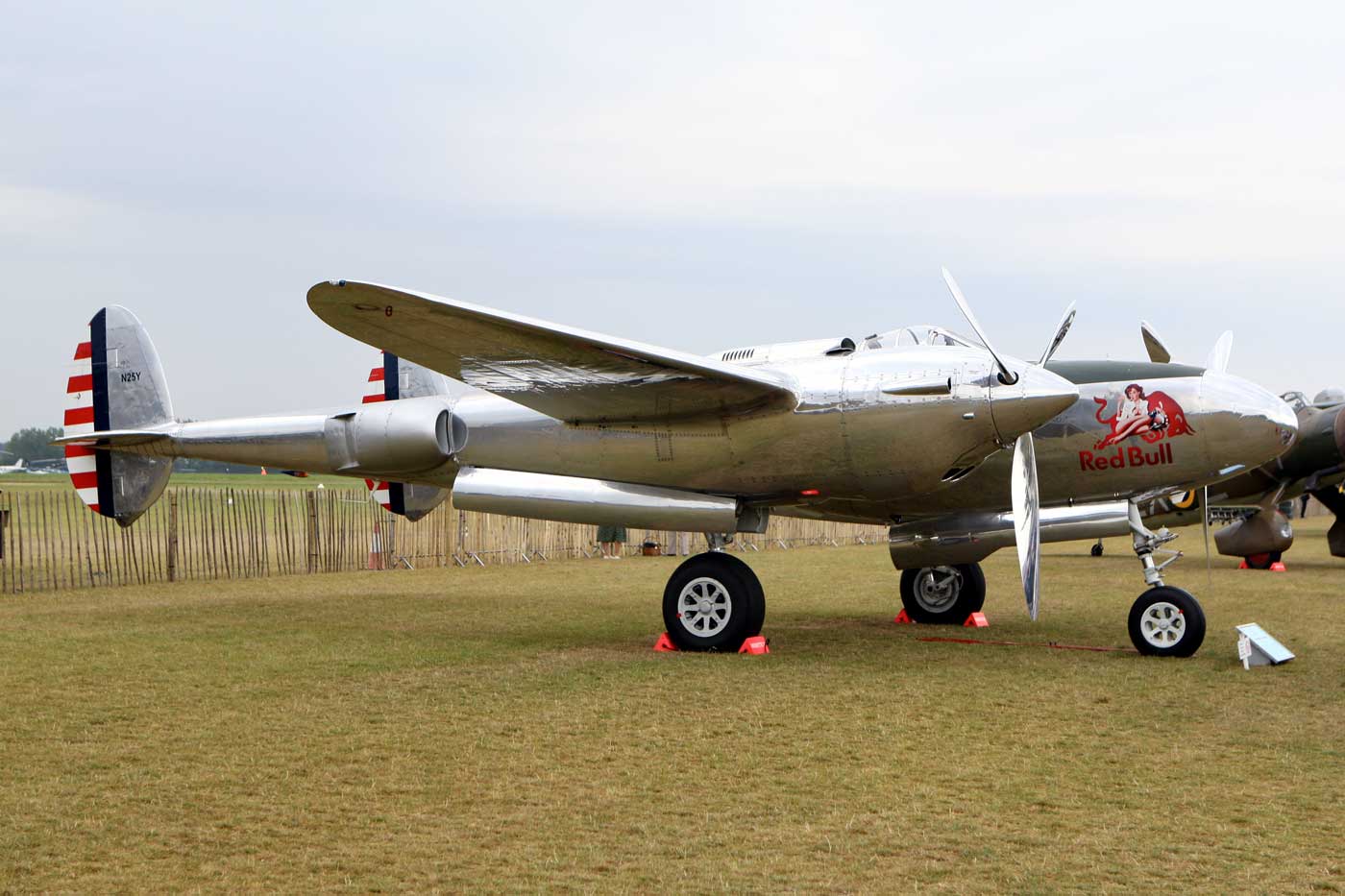
The brightest jewel in the Red Bull/Flying Bulls jewelry box is, to my mind, their 1944 Lockeed P38 F-5G-6-LO Photo Lightning. Struck off charge from the Air Force in September 1945, entered into the civil register as N25Y by the Lilee Products Co of Chicago and then into the care of JD Reed who was an air racing enthusiast.
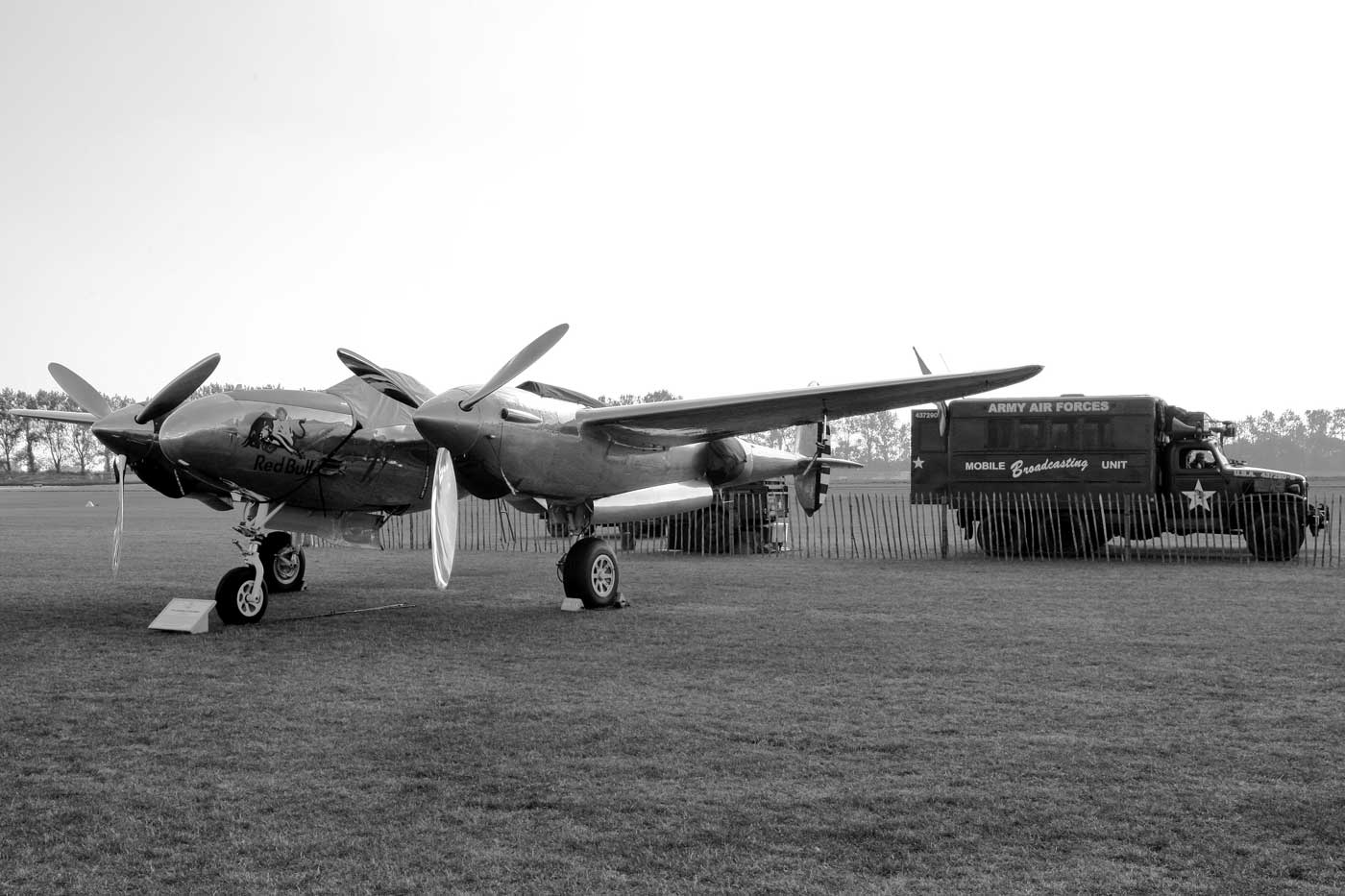
JD Reed then recruited Charlie ‘Firewall’ Walling as race pilot. Walling finished second in the 1947 Miami Air Races and at the Sohio Race in Cleveland. In 1963 N25Y passed into the hands of Marvin ‘Lefty’ Gardner who, following his high risk flights dropping supplies to the Norwegian resistance during WW2, was already a legend. Lefty proceeded to change her race number from 25 to lucky 13, painted her white and named her ‘White Lightning.’
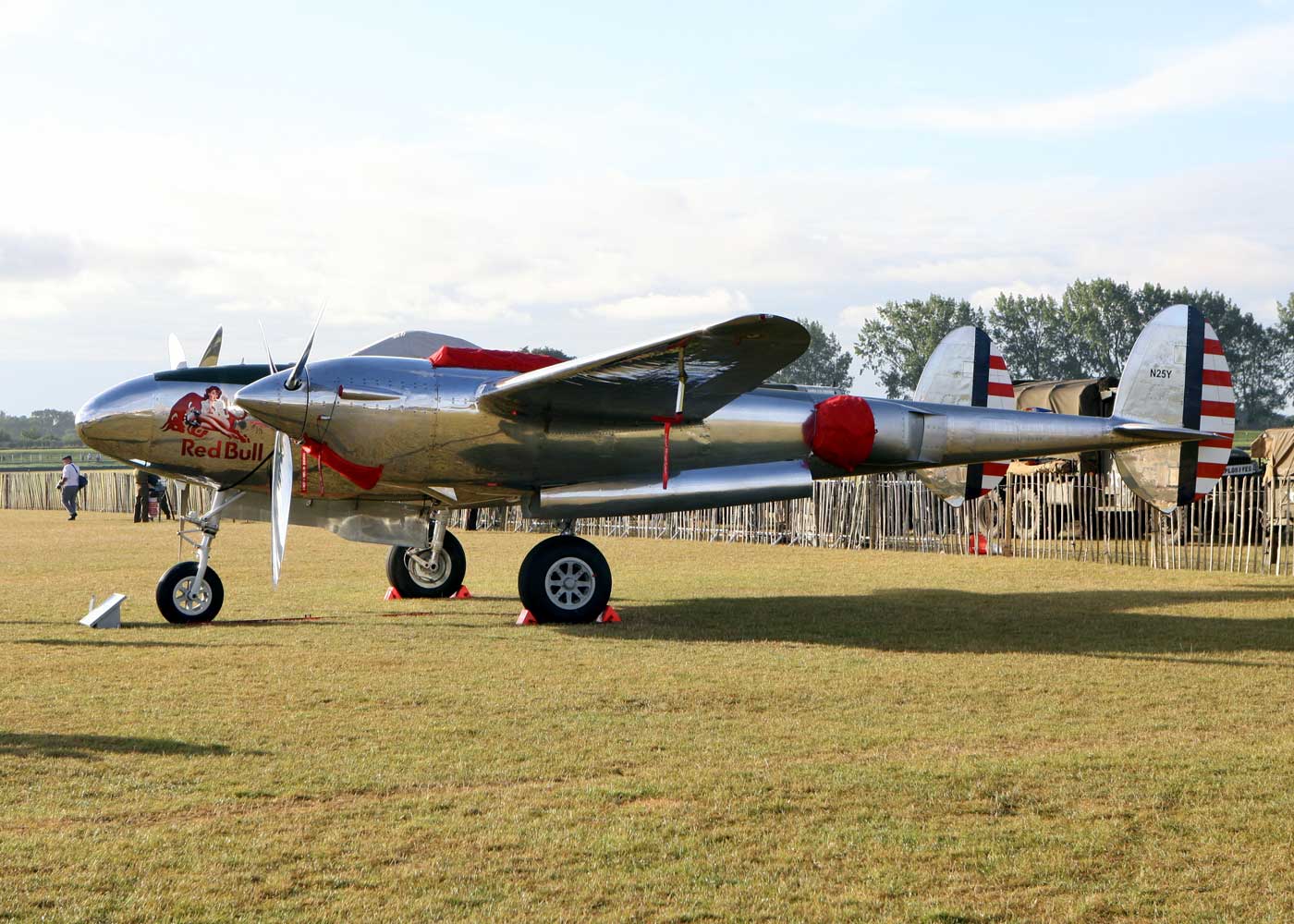
During the 60s Lefty thrilled the crowds at the Reno Air Races both with his precision aerobatics and with his race performances. However in 2001 disaster struck ‘White Lightning’, whilst being flown by Lefty’s son Ladd, a mid-air engine fire forced Ladd to make an emergency landing in a cotton field in Mississippi.

The wreckage was acquired by Red Bull and eight years later, following restoration by Ezell Aviation in Breckenridge Texas, N25Y took to the air again and has been wowing spectators across Europe ever since.
Vickers Supermarine Spitfire MKIX
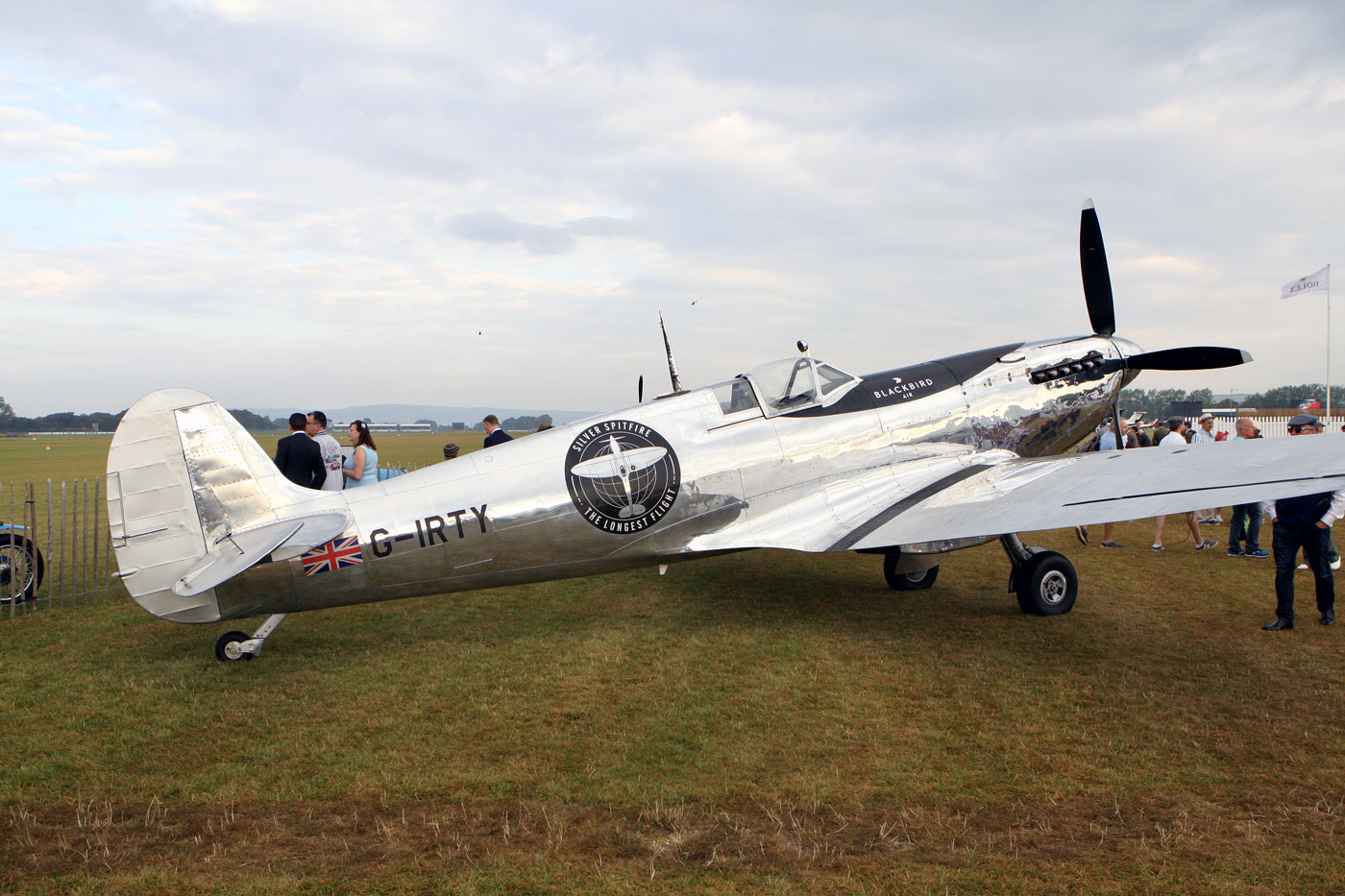
This Vickers Supermarine Spitfire MKIX MJ271 was built at the Castle Bromwich works and delivered to 33 Maintenance Unit at RAF Lyneham on the 24th October 1943. In February 1944 MJ271 was allocated to 118 Squadron based at RAF Detling in Kent where she flew 16 operational sorties escorting B17, B24 and B26 bombers attacking V1 launch sites.

In April/May 1944 she was transferred to 132 (Bombay) Squadron based at RAF Ford in Sussex where she flew a further 28 operational sorties including close air support and dive bombing targets on the French coast. On the 8th May she suffered a wheels up landing at RAF Ford.
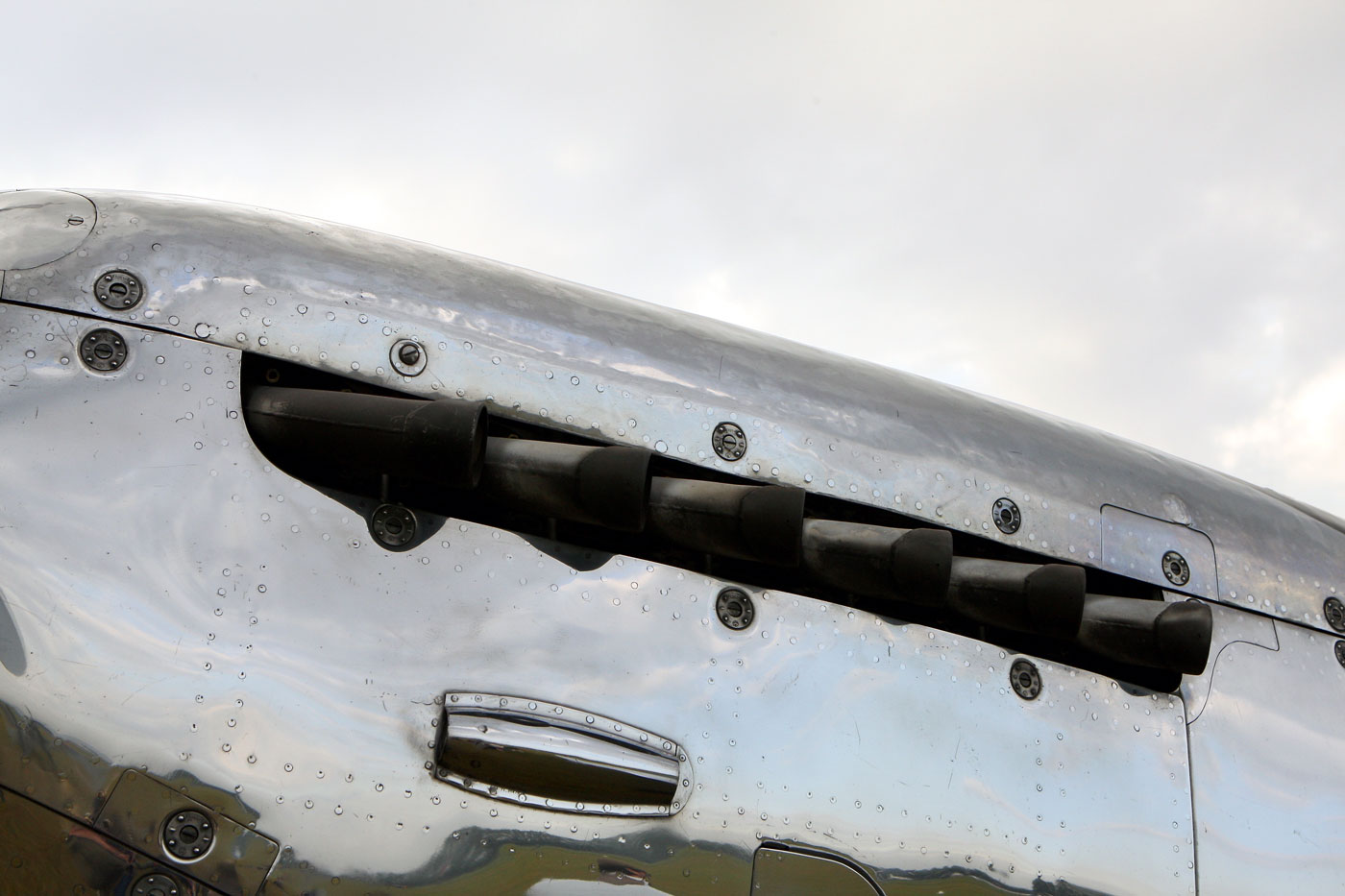
On the 24th December she was overstressed during a flight and was dispatched to 410 Squadron (RCAF), a repair and salvage unit. Following further repairs she was dispatched on the 25th November, 1946 to the Royal Netherlands Air Force and allocated the registration H-8. Later 3W-8, markings she would wear for the next 70 years before arriving at Duxford in Cambridgeshire to begin her new adventure as the ‘Silver Spitfire.’
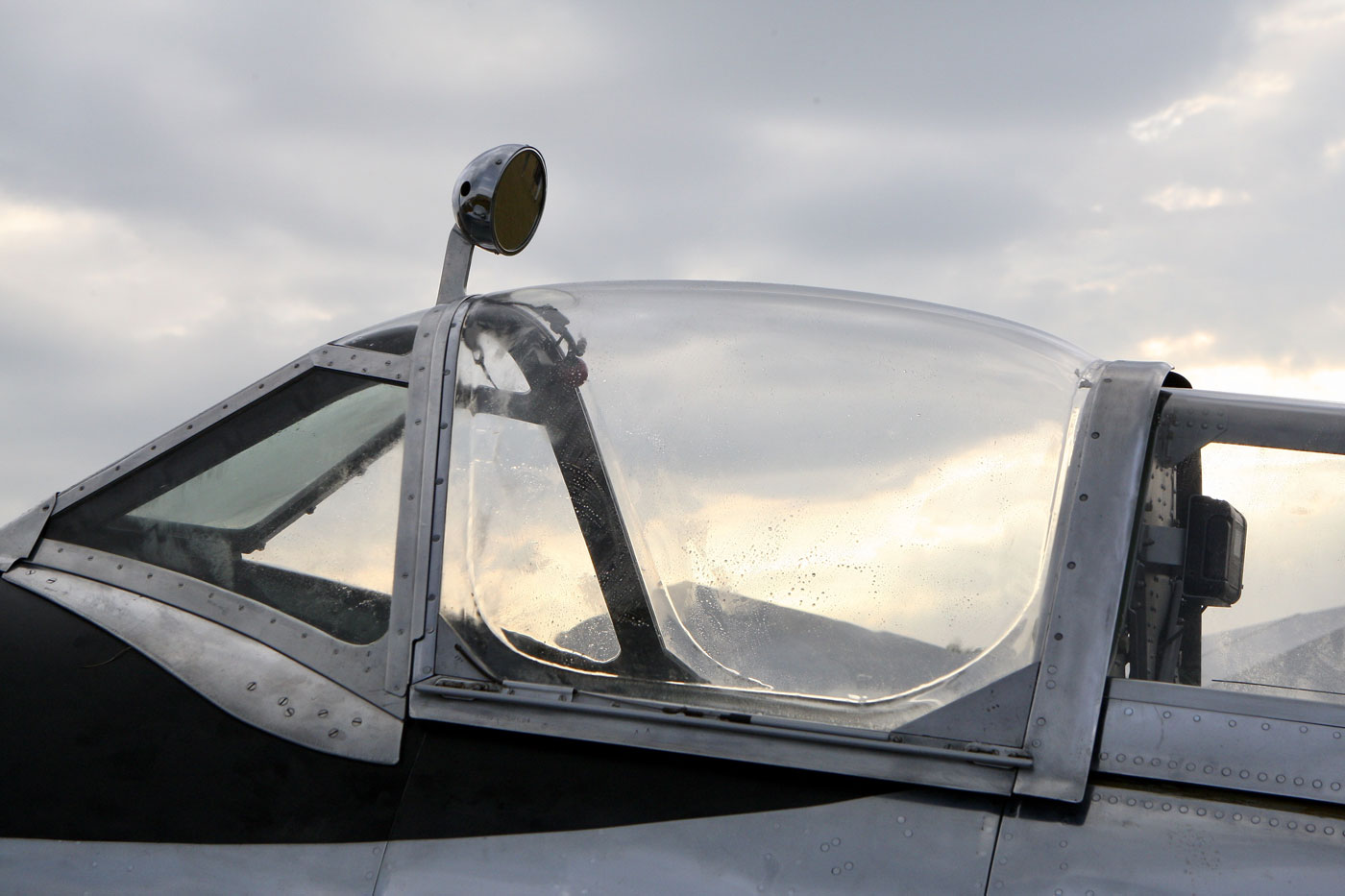
On December the 5th, 2019 Matt Jones and Steve Boltby Brooks accomplished their dream, to fly a Spitfire around the world. ‘The Longest Flight’, departed from the Goodwood Aerodrome on the 5th August. MJ271 flew north to Iceland, then across Greenland, into Canada, across the USA, then back into Canada and on to Alaska, across Russia and into Japan, then Taiwan, Hong Kong, Vietnam, India, Pakistan, Kuwait, Jordan, Egypt, Greece, Italy, Germany, Holland, landing back at Goodwood having flown 22138 nautical miles.
Vickers Supermarine Spitfire MK9
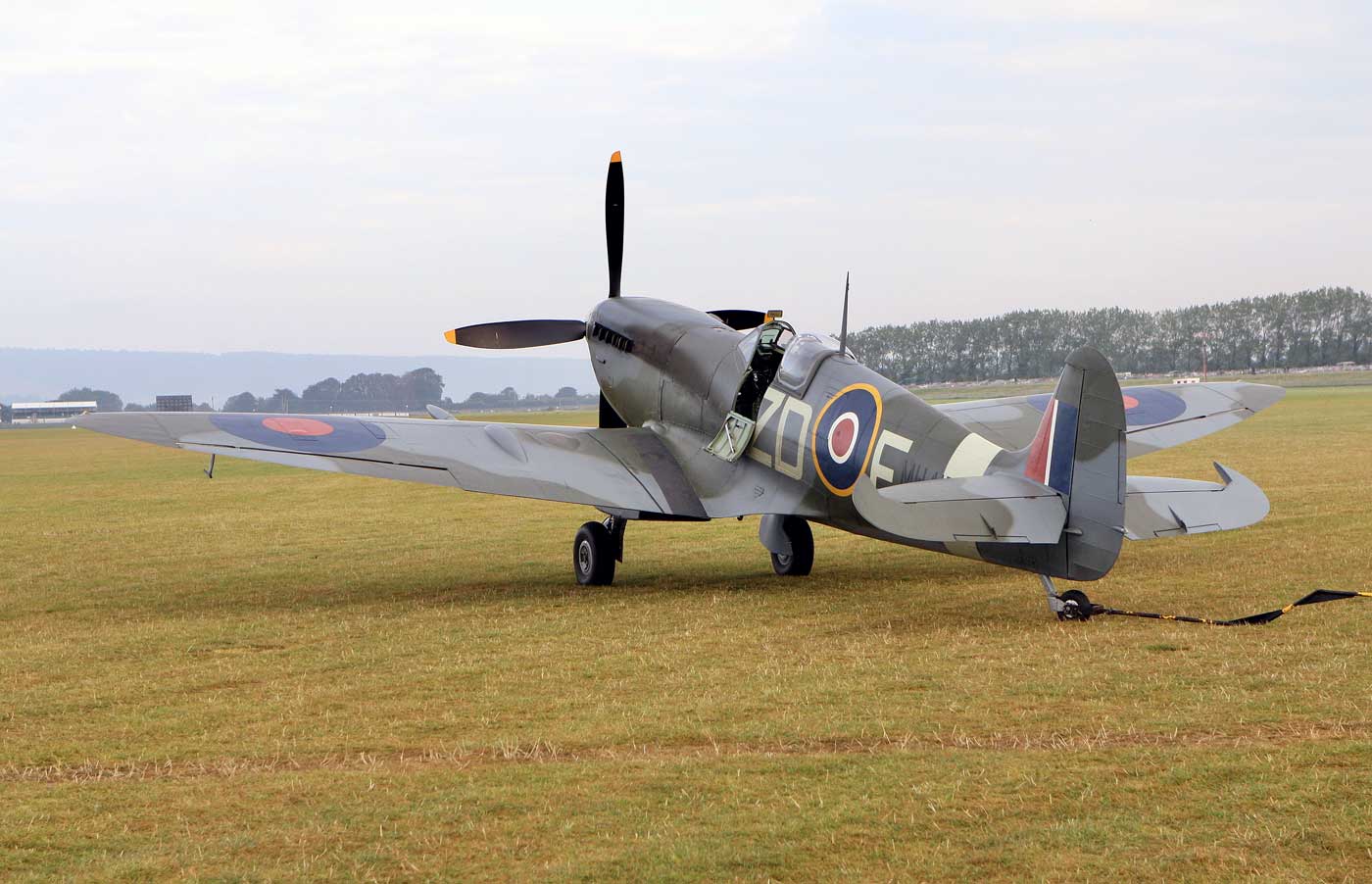
Vickers Supermarine Spitfire MK9 MH415, constructed at the Castle Bromwich factory, was allocated to No 129 Squadron (Mysore) based at Hornchurch in August 1943. Carrying the squadron codes DV-G she was often flown by Sqn Ldr Gonay. In October 1943 she was transferred to 222 (Natal) Squadron and remained in the thick of the action flying fighter sweeps into occupied Europe. In January 1944 she was relocated to RAF Wittering for a role in the Air Fighting Development Unit. In September 1944 she was allocated to 126 Squadron based at Bradwell Bay Essex. In January 1945 she was at Vickers Armstrong in Oxford for repair and maintenance. In 1946 she was sold to the Dutch Air Force and in 1947 she was shipped to Java as H-108 and then H-65 with 332 Squadron. Returning to Holland she was re serial B-12. In 1953 she passed to the Belgium Air Force as SM-40 where she served for a further 3 years. After her military service she was converted, painted in an attractive blue and white scheme, given the civil registration OO-ARD and used in the role of a target tug by a Belgium company. In the 1960s she appeared in several motion pictures including ‘The Longest Day’ and ‘The Battle of Britain.’ Once filming was finished, she was retained, along with many other film aircraft, by Wilson ‘Connie’ Edwards in lieu of payment and moved to Texas and registered N415 MH. Flown infrequently and then stored in the Edwards farm from 1973 in 2014 she was purchased from Platinum Fighters and shipped to Vintage Fighter Rebuilds in New South Wales. Registered G-AVDJ she took to the air again at Sywell in Northamptonshire on the 8th April 2021.
The Kent Spitfire
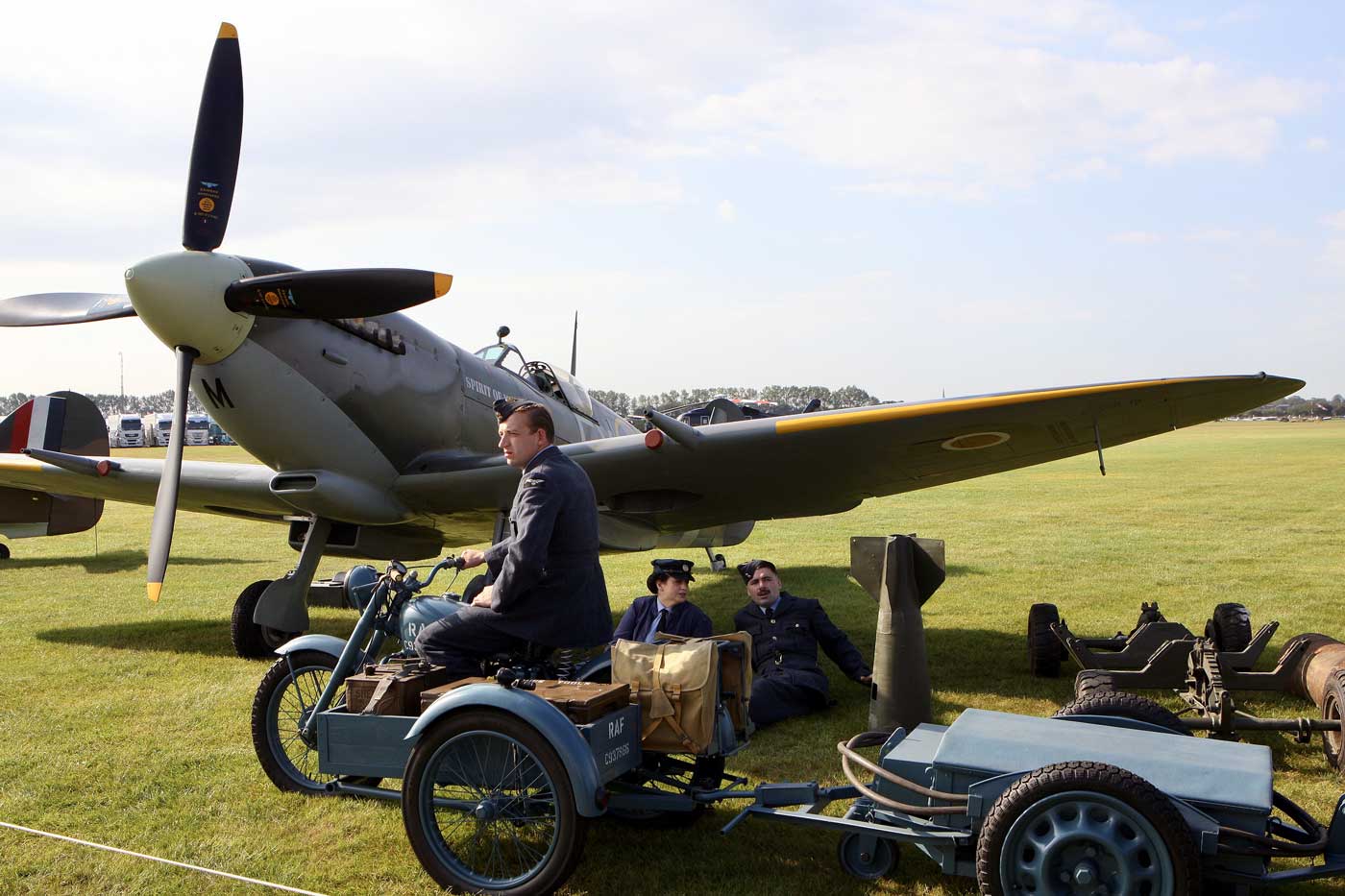
‘The Kent Spitfire’, TA805 was constructed at Castle Bromwich in late 1944 for the RAF and allocated to 39 Maintenance Unit and then allocation to 183 Squadron on the 24th June 1945. Transferred to 234 Squadron on the 2nd August 1945 and then on the 11th March 1949 she was delivered to the South African Air Force. Sent to the South African Metal and Machinery Co, Salt River Cape Town in 1954 for scrapping, by 1981 the hulk of the fuselage was moved to the SAAF Museum in Snake Valley. Between 1989 and 1995 the remains were owned by Steve Atkins of Oxford and then stored as a restoration project on the Isle of Wight, until being purchased by Peter Monk and Mike Simpson. Registered as G-PMNF and restored to airworthy condition by Airframe Assemblies at Sandown on the Isle of Wight, she took to the air again in December 2005 at Duxford in Cambridgeshire. Painted in the colours of 234 Squadron she is now operated by the Biggin Hill Heritage Hanger, Biggin Hill Aerodrome, Kent.
Spitfire MK1A

Owned by the Dan and Tom Friedkin/Comanche Fighters of Chino California but based in the UK, Spitfire MK1A X4650 was constructed at Castle Bromwich during 1940. Flying over North Yorkshire on the 28th December, 1940, Battle of Britain legend New Zealander Flight Commander Alan Deere was teaching new pilot Howard Squire of 54 Squadron how to keep close to an enemy fighter. “Stick to me like Glue” were the instructions. Squire, flying in X4650 got too close and hit Deere’s (in X4276) tail with his prop at 12000 feet. Both pilots escaped unhurt but X4650 crashed at Red Hall Farm, Kirklevington. During the hot summer of 1976, the wreckage was discovered in a dried up river bed, and was restored to airworthy condition by Peter Monk. X4650 returned to flight on the 12th March 2012.
Non-combatants
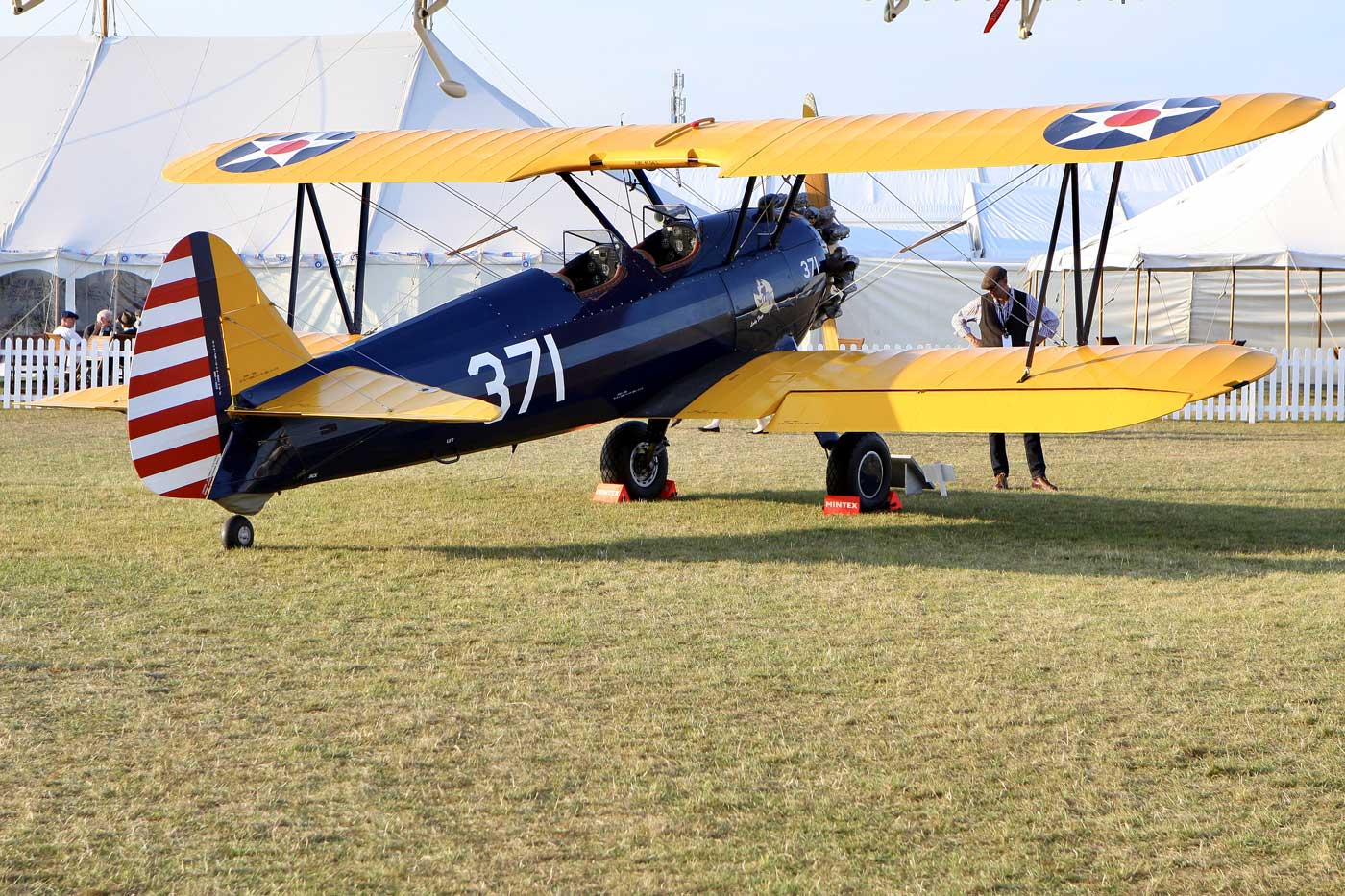
Colin Wills Boeing Stearman A75NI G-CKXY left the factory in 1941 for service with the United States Army. Sold out of service in the USA and allocated the civil registration N67238. Subsequently imported into the UK and given the registration G-CKXY. In 1934 the Stearman Company designed and built a biplane trainer for the United States Armed Forces designated the model 70. This aircraft was followed by the model 75 which became the Boeing Stearman when the company was taken over. The Stearman went on to become the standard trainer for the US Army and Navy with over 9800 examples being built. This example was fitted with the 220 hp Continental W670-6A radial engine.
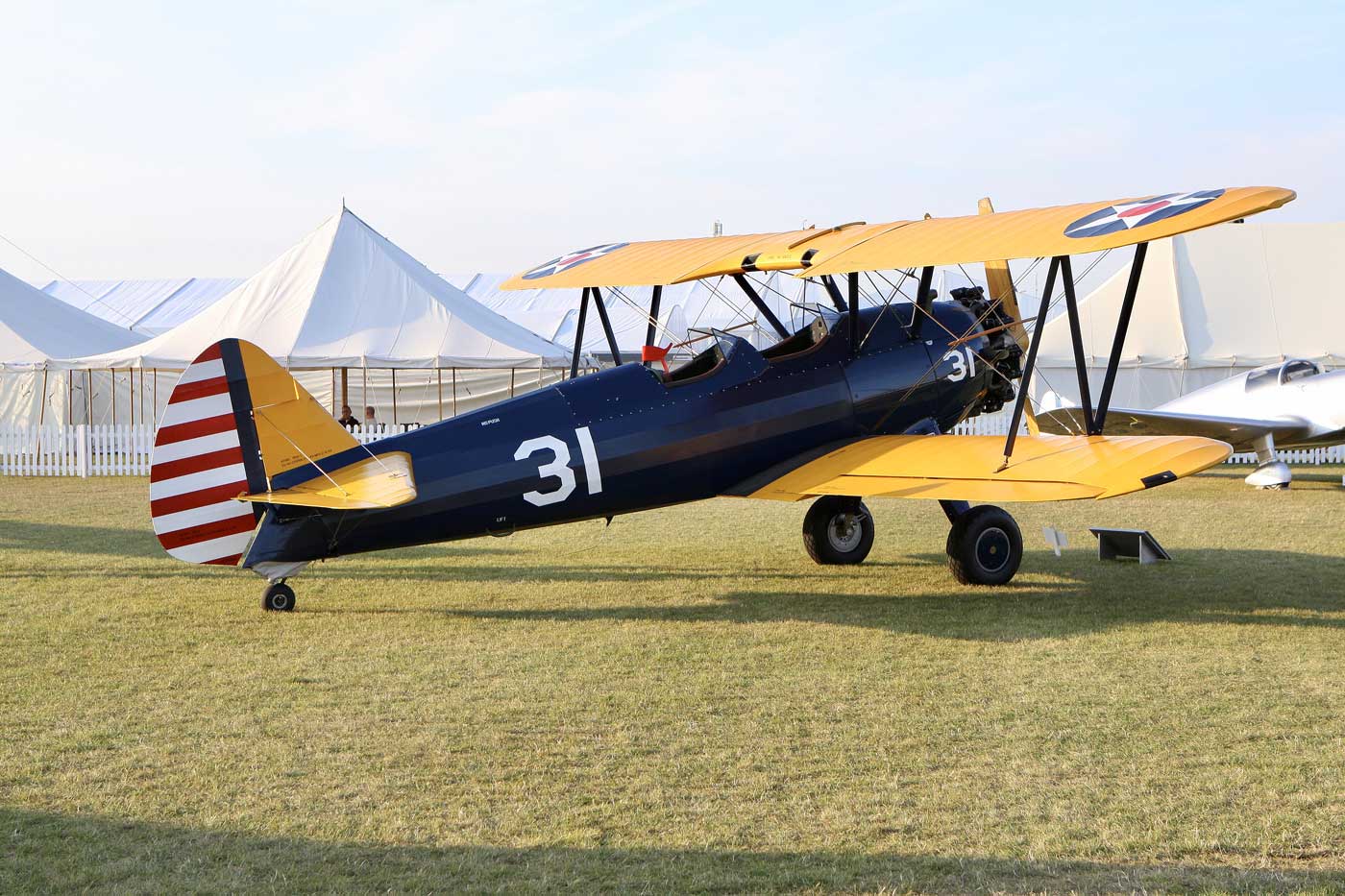
Richard Butterfield’s Boeing Stearman was constructed as a Kaydet version in November 1943, registered NC51772 and allocated to the US Navy training fleet. Later in the war it was reassigned to the US Army for Pacific based training before being returned to US soil and given its original Navy colour scheme which it still retains today. Following 15 years of service with the US armed forces it was left derelict until restored in 2015, retaining its original Continental W670-6N 220 hp engine.

Edwin Boshoff’s Beech D17S Staggerwing was built in 1939 for evaluation by the US Army Air Corp. Sent to the UK for use by the US Air Attache and then transferred to the RAF as a Traveller MK1 reg DR628. In 1947 the Staggerwing was returned to the USA and then purchased in the UK in 1950 registered G-AMBY. The Staggerwing then went to Rhodesia and as VP-YIV, and after several more owners in the USA the Staggering was obtained and operated by Southern Cross Aviation.
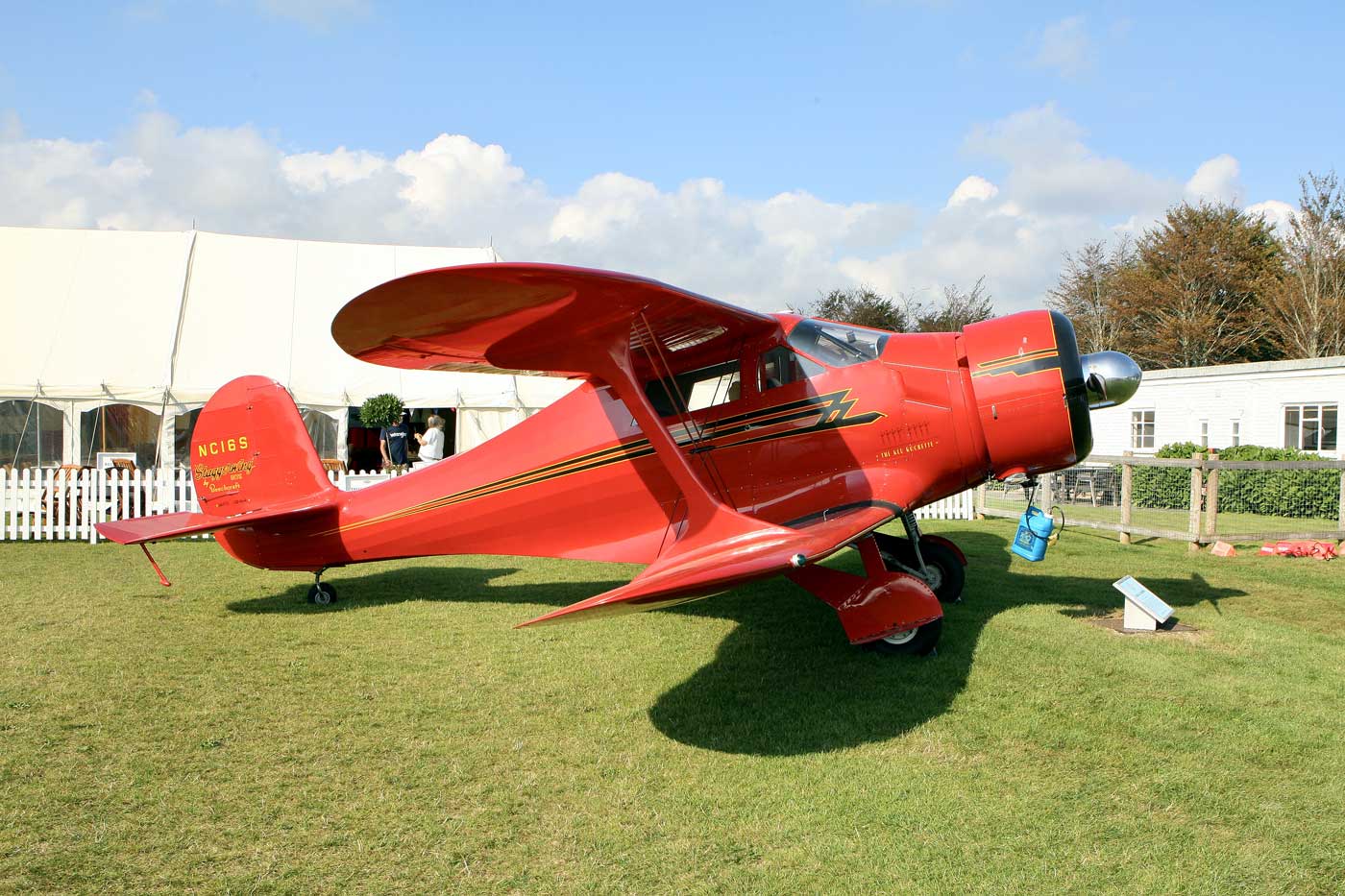
Bill Charney’s Beech D17-S Staggerwing was built at the Wichita Factory in 1944 for the US Navy. The Staggerwing was then shipped to the UK under the Lend Lease scheme for use by the Royal Navy as a Traveller MK1 FT466. Returned to the USA in 1946 the aircraft has had many owners and a few restorations, the most recent being carried out in New Zealand.

Now owned by the Goodwood Road Racing Company, this North American Harvard 11B was, for 21 years, owned by the musician Gary Newman. Built by Noorduyn Aviation in Canada in 1943 and shipped to the RAF in 1944 before service with the Royal Netherlands Air Force in 1947. Later moved to Sweden the Harvard received its civil registration in 1969 and by 2005 was under the care of the Goodwood Flying School. The display of the Harvard was tinged with sadness following the death in July 2021 of Rob Wildeboer, the flying School Manager who had logged many hours on her.
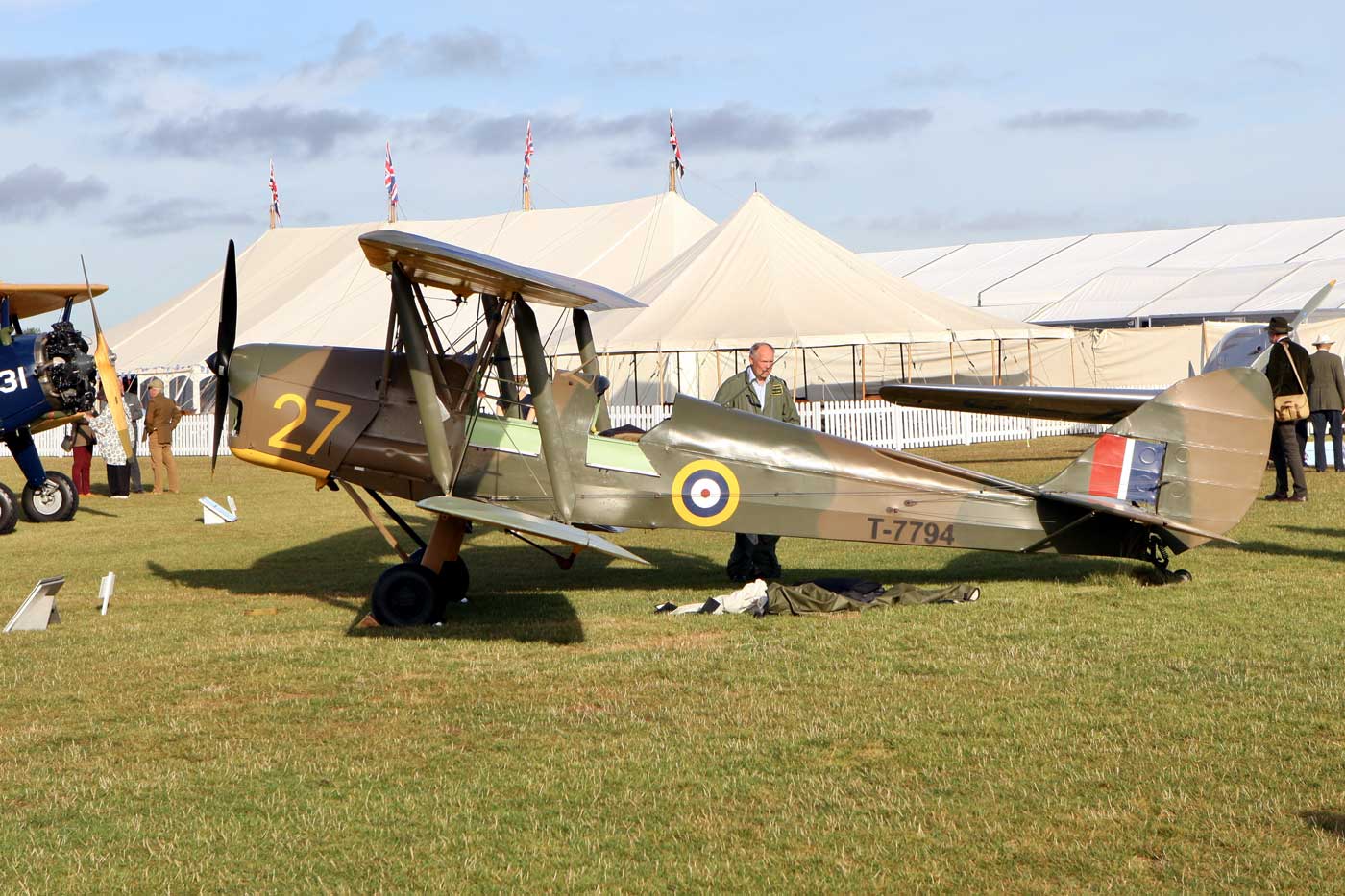
Richard Menage’s De Havilland 82A Tiger Moth was built by Morris Motors in 1941 and delivered to the RAF where it was registered T7794, then sold into the civilian market and registered G-ASPV in 1953. Restored in 2008 at which time she was returned to RAF camouflage markings and given her original registration number.
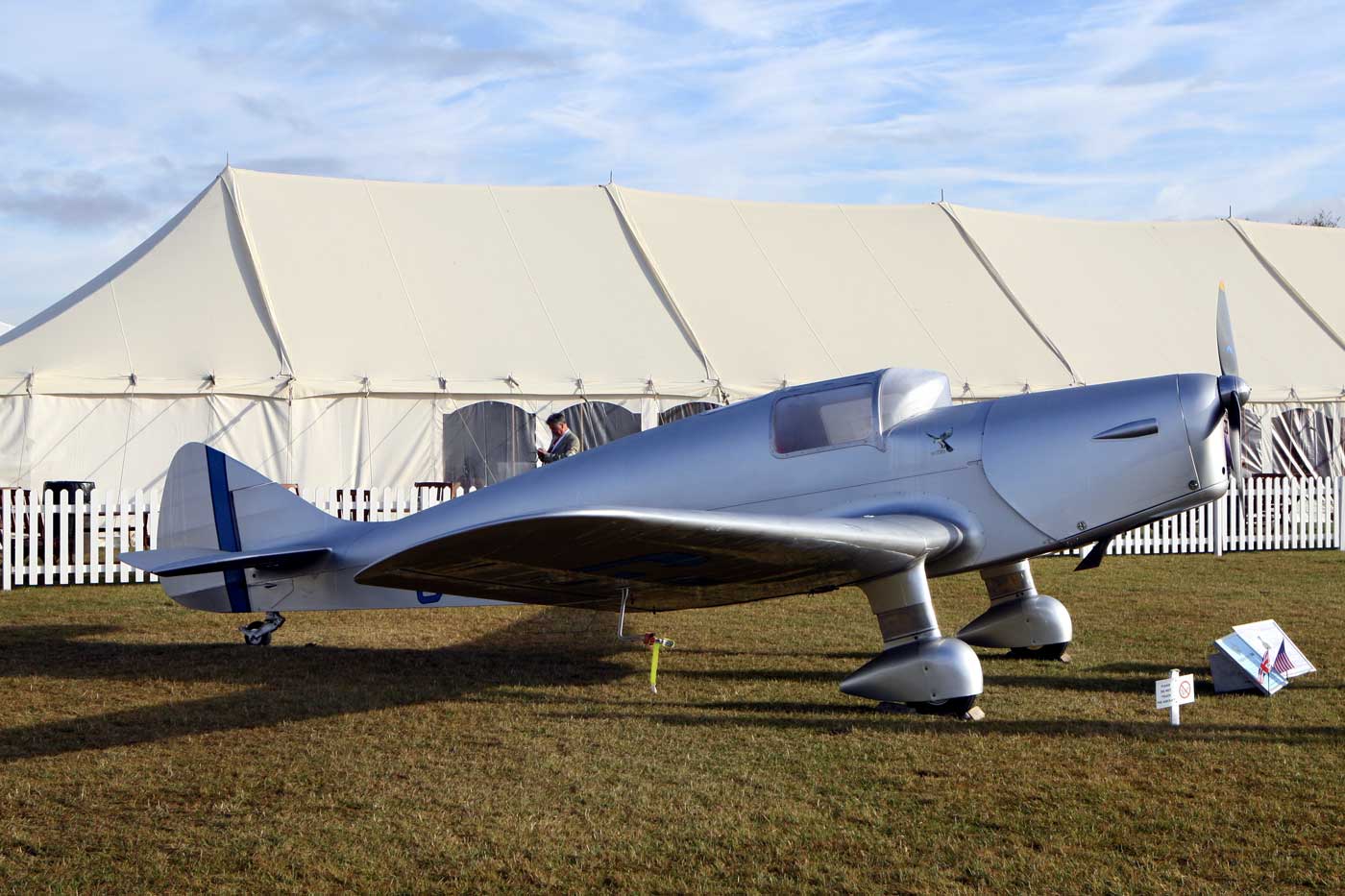
In the 1930s Maserati race driver Whitney Willard Straight operated flying clubs throughout the UK during which time he collaborated with FG Miles to design a modern, comfortable, light aircraft. The Miles M11 Whitney Straight made its first flight in 1936. Peter Bishop’s example G-AERV was constructed in 1936 and sold to a London-based customer. Several English based owners followed before being purchased by a Northern Ireland owner in 1962. Following a crash landing in 1963 the M11 was stored until being purchased, in a poor state, and restored by Aero Antiques. Of the 50 examples constructed this is the only flying example left.
The Winners

Ordered by the US Army in 1947, and first flown in December 1949, the Cessna Bird Dog was the first all-metal aircraft used by the US army for liaison and observation. Initially designated L19A (Liaison) and then redesigned O-1 (Observation) in 1962. Between 1950 and 1969 3398 examples were constructed. Shona Bowman’s example, G-VNAM, was built in 1951 and allocated to the US Army to train Japanese pilots. Following the Korean War G-VNAM moved to Japan where it remained until the 1970s. In 1980 G-VNAM was transferred to the Civil Air Patrol and was used to tow gliders in Honolulu for the next 35 years. In 2017 it was purchased in the UK and restored to a 1965 Vietnam war USAF scheme to commemorate the O-1 pilots.
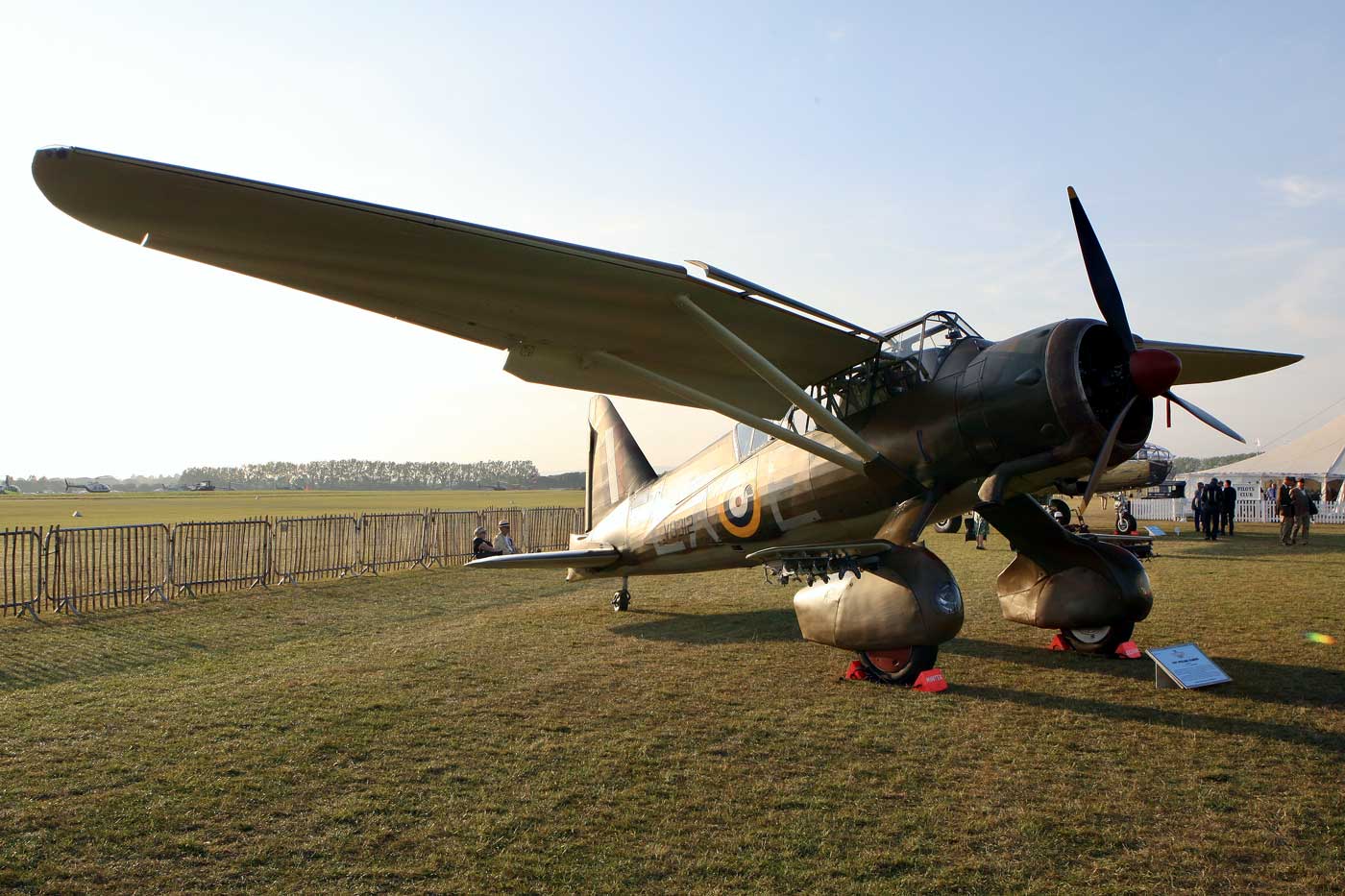
Entered by John Romain Westland Lysander G-CCOM was issued to 225 Co Operation Squadron in April 1941 with the registration V9312. After serving with various squadrons V9312 was transferred to Canada in 1942 for use as a trainer. In 1946 a Saskatchewan farmer purchased the airframe. The present owner purchased V9312 from a subsequent owner in the USA and restored this very rare aircraft to flying condition over many years. The Westland Aircraft works was formed by Petters Ltd at Yeovil in 1915, with Westland Aviation being set up as a separate company in 1935. Designed to meet Air Ministry Specification A29/34 the Lysander first flew in 1938. The Lysander and her brave crews are best remembered for their clandestine flights into occupied Europe.

John Heath’s Westland Wasp MK1 G-RIMM (serial XT435) was constructed in 1964. Following the purchase of the Saunders Roe company by Westlands, the P531 design was developed into the Westland Scout for the Army, and the Wasp for the Navy. Powered by a Rolls-Royce Nimbus gas turbine engine, the Wasp version was fitted with a fully casting undercarriage for ship-bound use. Entering Royal Navy service in 1965, XT435 operated at various Naval stations including Culdrose, Portland and also Borscombe Down. Following withdrawal from Naval service XT435 served with the New Zealand Navy before being sold into private hands in 1983.
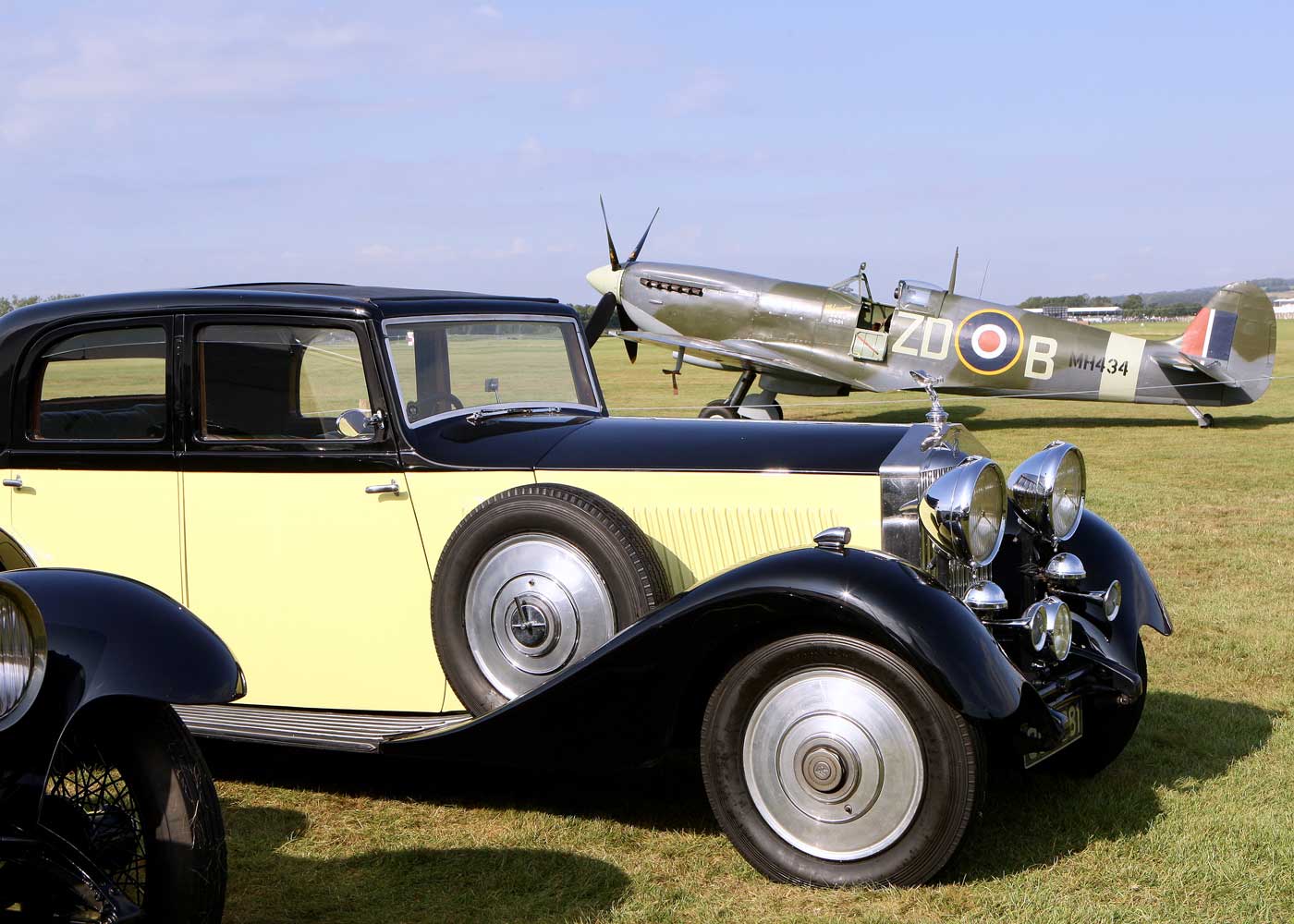

Thank you for sharing these great photos of such wonderful aircraft
Great pics and stories behind them!
Awesome!
Thanks for also talking about my other love, aviation!